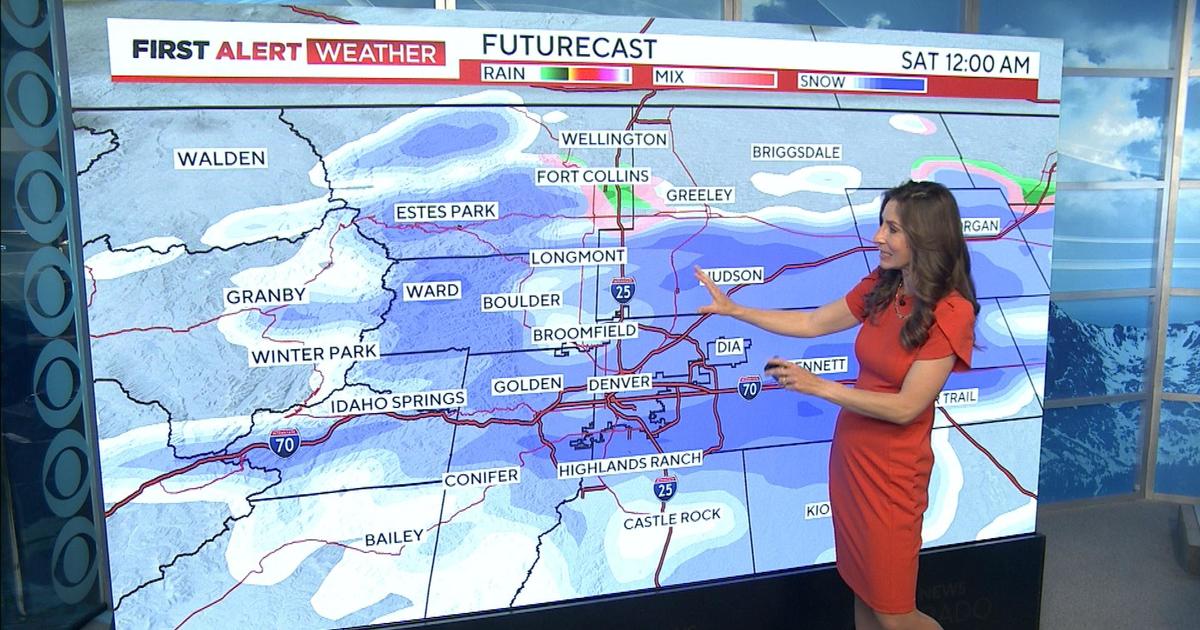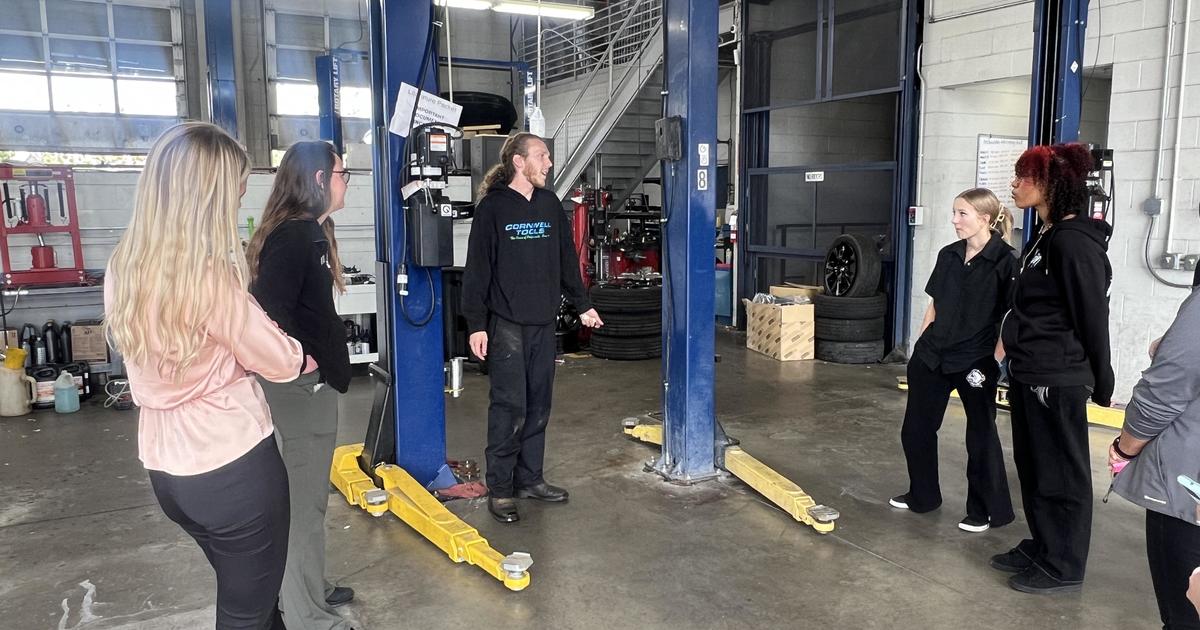Colorado Sees Trend Of Ski Mountaineering Climbing
GLENWOOD SPRINGS, Colo. (AP) - There are no chairlifts and there's no lift ticket. There's no watery hot chocolate, no over-priced French fries or luke-warm pizza. There's no swerving around schools of toddler skiers and no paying $20 to park the car.
There's some planning, some exertion and even some danger, but if you do it right, ski mountaineering is just you, your skis, your friends and the snow.
It's also the fastest growing segment of the winter sports industry, and an increasingly popular form of fun for skiers and snowboarders in the Roaring Fork Valley.
"Touring equipment is the fastest growing category in the outdoor sports market," said Randy Young, who founded the Cripple Creek Backcountry ski shop in Carbondale with partner Doug Stenclik last fall.
Broadly, the term "ski mountaineering" refers to the act of putting climbing skins on your skis and walking up a mountain, then, removing the skins and skiing down.
Under that umbrella, though, are skiers who skin up groomed ski resorts for fitness, skiers who access backcountry terrain from the top of ski resorts, and skiers who descend 14,000-foot peaks after skinning up with climbing gear in tow.
The Roaring Fork Valley is also a center of the growing "skimo" racing scene.
"You know the sport has grown because it's become fragmented," said Young. "It now has a 'side country' segment, a backcountry segment and a fitness segment."
In part, the sport's growth in recent years is due to the rise in popularity of the alpine touring (AT) binding, which allows alpine skiers to lift their heels and ascend a slope, an ability previously enjoyed by telemark skiers alone.
"It used to be the case that you had to learn to telemark if you wanted to get into the backcountry," said Ryan Fulton, assistant manager at Summit Canyon Mountaineering shop in Glenwood Springs, which carries backcountry skiing gear.
"That's no longer true."
Perhaps no one has watched the ascension of ski mountaineering in recent years with as much interest as Lou Dawson, an acclaimed mountaineer and backcountry skier, and the author of the popular backcountry skiing blog WildSnow.com.
Dawson, who lives in Carbondale, was the first to ski all of Colorado's 14,000-foot peaks.
But when he started backcountry skiing in the 1970s, he said, the sport was so obscure that he sometimes couldn't find a friend to ski with.
"As more and more people do these sports, it develops a critical mass," he said. "It's like a snowball effect. We profess to want solitude, but generally we want a social experience, and today it's easier to get that with backcountry skiing than it used to be."
The inexorable annual rise of ski pass and lift ticket prices at ski resorts across the country has surely boosted the sport's popularity. But, Dawson says some resort skiers have also simply gotten bored.
"Ski resorts for years sterilized the ski experience, and kept boundaries really tight," he said. "They essentially dumbed down skiing. Backcountry touring offers fun and adventure that you can't necessarily get at a ski resort. You feel like you can get a little adrenaline pumping."
Part and parcel with the need for a squirt of adrenaline is the endless desire for untracked powder, which is in higher supply (and lower demand) throughout much of the backcountry than at the resort.
In the Roaring Fork Valley, areas like Williams Peak, Marble Peak, the backside of Aspen Mountain and Independence Pass have seen growing rates of skier traffic in recent years as more people strike out in pursuit of untracked snow.
Dirk Bockelmann, the general manager of Aspen-based guiding company Aspen Expeditions, says powder hounds are the core of his business, and that business is growing.
His guides take skiers with telemark or alpine touring gear to the backside of Aspen Mountain, the backside of Aspen Highlands or to other areas where a short hike can yield a long run.
And if his clients want a second run, the odds are good that the snow will still be fresh.
"On a powder day at the resort, within an hour everything is tracked out," said Fulton. "You don't get the tracked-out powder in the backcountry."
Sensing skiers' growing hunger for backcountry terrain, ski areas like Crested Butte, Telluride and Aspen have been opening more lift-access backcountry runs, also known as 'side country,' in recent years.
During the 2012-13 ski season, for instance, Aspen/Snowmass opened up 230 acres of new terrain in the Burnt Mountain area of Snowmass Mountain.
Spend a few hours at a local ski resort on any given day, and you're likely to see at least a few stalwart aerobics junkies skinning up the side of a run.
For time-strapped skiers who want a hard workout capped with a few turns, resort skinning is the perfect sport, and its popularity is driving a large share of the business at local backcountry ski shops.
"A lot of people just want to skin uphill at Sunlight (Mountain Resort)," said Fulton. "That's a lot of our clients."
The trend is similar in Aspen, Bockelmann said, and it's a trend driven by former hikers and road bikers who are drawn by lightweight and high performance AT gear.
"The fitness explosion has been amazing around here in just the last three years," he said.
Resort skinning remains free at Sunlight Mountain and the Aspen/Snowmass ski areas, although some mountains, including Crested Butte, have begun charging skinners a small fee (Crested Butte charges $10 a day).
"All mountain managers are taking a fresh look at in-bounds skinning," said Bockelmann. "You are probably going to see more of them requiring an uphill ticket in the future."
At the extreme end of the fitness craze are those who climb and ski local peaks, and the season for that is just beginning.
From late March through May, as temperatures warm, the snowpack enters a cycle of melting and freezing that can stabilize its upper layers. That makes it much safer to ski long and steep terrain that's highly avalanche prone during the winter.
Bockelmann cautions, though, that the snowpack in the Aspen area hasn't reached a spring consistency yet, and avalanche danger remains considerable, particularly on south facing slopes.
Some local peak skiers are also active in the growing ski mountaineering race scene, governed by the U.S. Ski Mountaineering Association.
Two of the association's races are held locally: The Heathen Challenge at Sunlight Mountain and the Power of Four race at Aspen/Snowmass.
And, the valley is home to some top talent on the racing scene: Aspen locals Max Taam and John Gaston, who won the Power of Four race this year, also placed 10th at the ski mountaineering World Championships in Puy-Saint-Vincent, France in February.
Perhaps the largest force behind the recent growth of ski mountaineering is the rise of the alpine touring sector, which has seen a rapid rate of gear innovation in recent years.
As the number of backcountry users continues to increase, avalanche forecasters and backcountry guides say it's leading to a sharp increase in the number of skiers exposed to avalanche danger.
Brian McCall is the Aspen zone forecaster for the Colorado Avalanche Information Center, which puts out a daily avalanche forecast for zones throughout the state.
He says the increased exposure is partly due to better gear that gives people access to new areas of the backcountry.
"We've had wider skis and we have lighter gear that allows people to get into the mountains in more remote places in different conditions," he said.
"That improved technology is making access easier, and allowing people to get to places where we haven't seen them in the past."
Higher rates of backcountry use have also corresponded with a growing interest in avalanche education courses. Aspen Expeditions has long offered courses accredited by the American Institute for Avalanche Research and Education, and Colorado Mountain College has also started featuring the courses at campuses throughout the valley in recent years.
It's not clear, however, that education has kept pace with risk exposure in the backcountry.
"Certainly, the overall level of experience with avalanche conditions among skiers in the backcountry has gone down," said Dawson.
"You have more people out there who have been doing it for less time, and have had less exposure to snow science."
The popularity of extreme ski movies, and the ever-present craving for powder skiing, has also led some skiers to increase their risk tolerance, Dawson said.
"There's a lot more motivation to ski more dangerous stuff," he said. "It now seems like if it's not on Facebook and you're not getting face shots, it didn't happen.
"People are doing amazing things out there, but there's this expectation that everyone is going to ski the powder run of their lives, and that leads people to ratchet up their risk acceptance," Dawson said.
- By NELSON HARVEY, Post Independent
(© Copyright 2013 The Associated Press. All Rights Reserved. This material may not be published, broadcast, rewritten or redistributed.)



